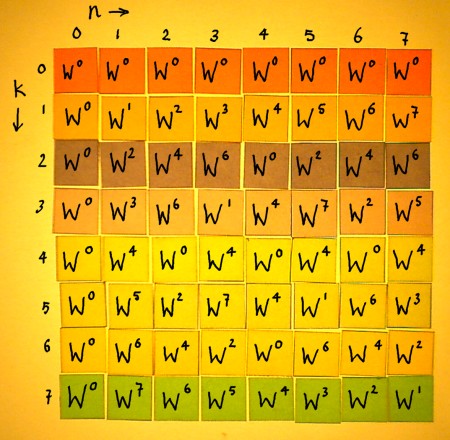

On this page I want to figure out a modest example of Fast Fourier
Transform. Even for the simplest form of FFT, we need quite some
ingredients:
Anyway it is comfortable that I can now recycle some work of the
other pages. Here is the N=8 Fourier Matrix, with it's complex entries Wkn
computed modulo 8:
 |
 |
We are going to decompose the Fourier matrix into three sparse
matrices of the form that was sketched earlier. Recall that these were
aggregates of identity matrices at different resolutions. On the left
is an aggregate of 16 1x1 identity matrices, in the middle we have
eight 2x2 identities, and the right matrix is composed of four 4x4
identities. All these identities must be replaced by Wkn
powers. Somehow.
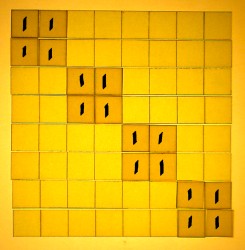 |
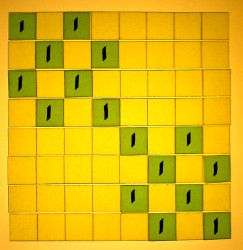 |
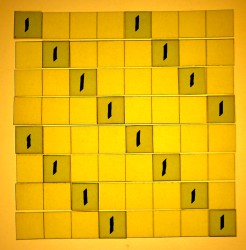 |
Well for the moment it is better to think in terms of roots instead
of powers. My page Roots
of Unity demonstrated how a whole set of Fourier harmonics can be
generated while multiplying and adding merely the 'octaves', which are
related to each other as squares and square roots. This is a phenomenon
that we can use for the matrix decomposition.
The square roots of unity have W0 and W4 in
the N=8 case, as is shown in the picture below:
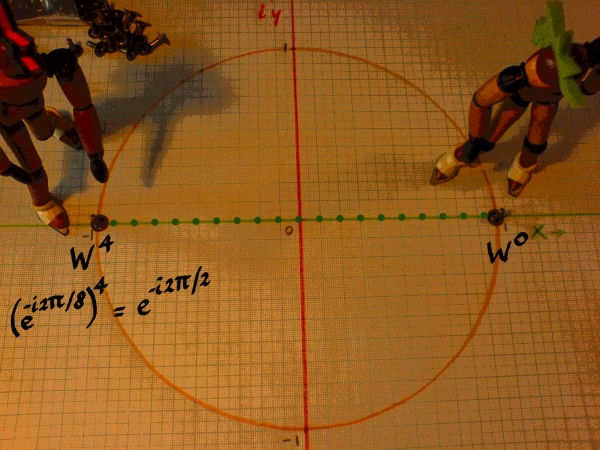 |
The square root of the square root is the fourth root. Expressed as
powers of W=e-i2pi/8, the fourth roots of one are: W0,
W2, W4 and W6.
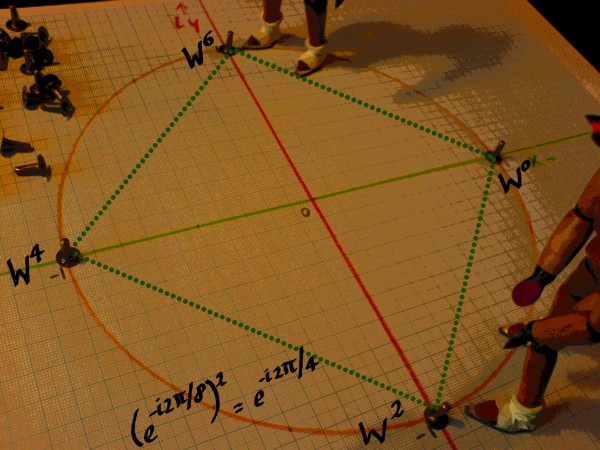 |
Taking the square root of the fourth root we land at the 8th root
finally. For N=8, we can not go further than this.
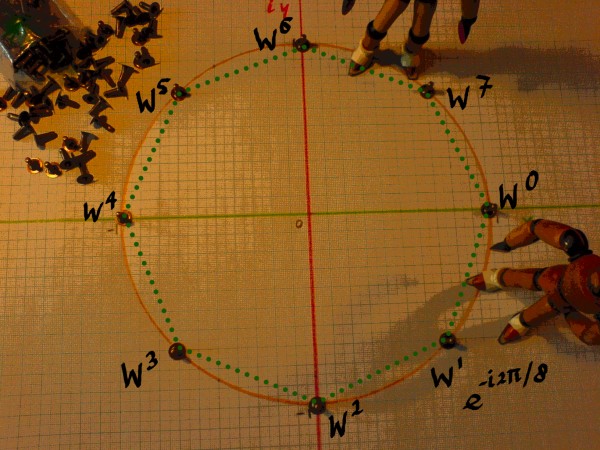 |
On the Fourier Matrix page the sine and cosine series for these
cases were plotted. I put those plots together here:
 |
|
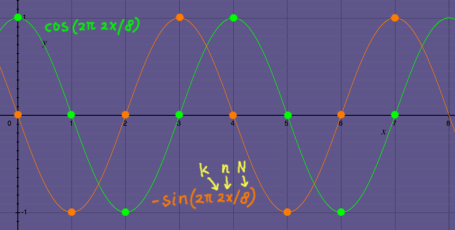 |
|
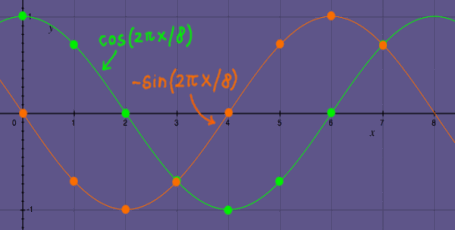 |
|
There is still one important series missing. It is the first root of
unity, or 11/1, and it's powers.
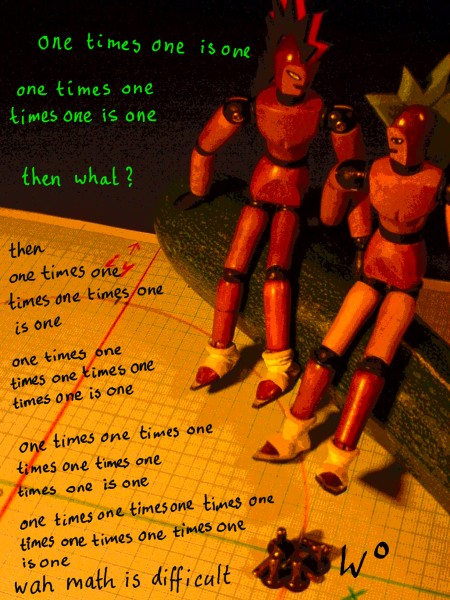 |
That sounds quite trivial indeed. But the fact that W0
operates as an identity follows from our definition of W as being a
complex root of unity. I feel we should remain aware of that. W0
is the most-present root in the Fourier
matrix. It's power series dominates the FFT. The series forms an
identity with respect to rotation. It is a conservator of frequencies.
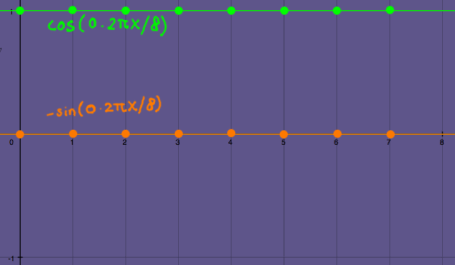 |
|
Let us look at the Wkn matrix once more, and confirm
which harmonics we are going to use, and which ones are skipped:
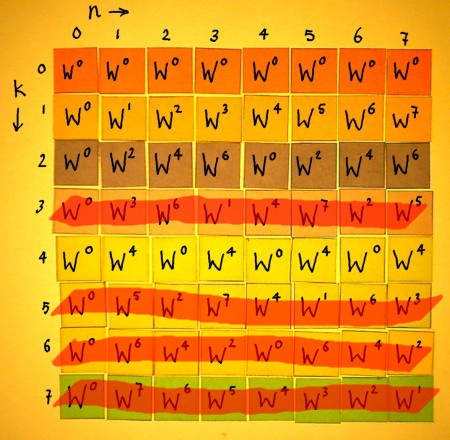 |
The question is now, how are we to arrange these frequencies in our
N=8 sparse factor matrices? Sure this can be derived from the DFT
formula, using a sequence of equations. These are fairly complicated
however, and I always lose track at some point when studying them.
Otherwise, there are these butterfly schemes that accompany most texts
on FFT. But I am not a fan of
that either. Maybe it is an idea to translate an FFT butterfly scheme
to a matrix representation.
To find a suitable scheme I studied more butterflies than I ever
wanted to see, none of them being precisely what I needed. I sort of
distilled a form that will
serve the purpose of this demonstration. Here we start with the first
sparse factor, containing first roots of unity in the upper part and
eight-roots of unity in the lower part:
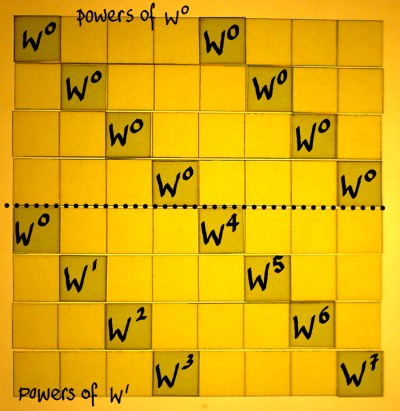 |
When we consider the next sparse factor as a repetition of the
process at another resolution, then we see the W0 series on
top again. Powers of W2 are in the lower halves. W0,
W2, W4 and W6 are the fourth-roots of
unity here.
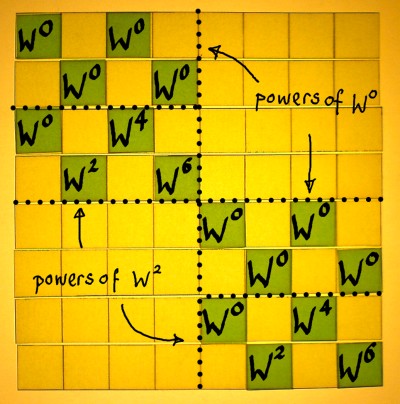 |
And here is the third sparse factor, it is the last one for the N=8
case. We find the W0 and W4, square roots of
unity, in the lower parts of the small submatrices.
 |
For convenience, the three factors are pictured together here:
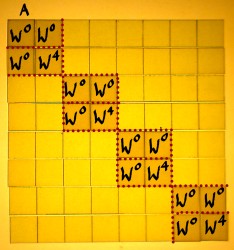 |
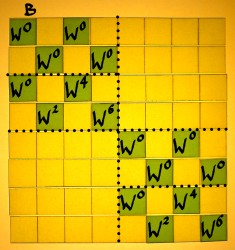 |
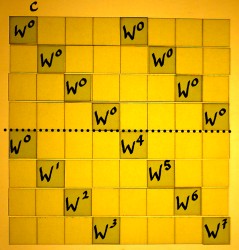 |
From these matrices, you could already have the impression that it will split output results into smaller and smaller vectors in every stage. The upper half of each submatrix has merely identities summed, while he lower half has rotations.
Let us now verify whether these sparse matrices multiplied will
really render the complete Wkn matrix. First multiply B with
C to get BC.
 |
 |
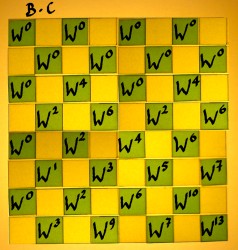 |
Then multiply A with BC to get the full matrix ABC:
 |
 |
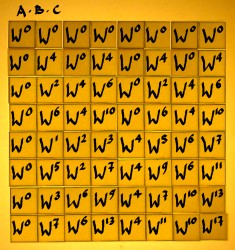 |
Some of the entries have exponents above 7, and these are to be
computed modulo 8. Below we have ABC in a form which can be compared
with the Wkn matrix. Hey, it is interesting: all harmonics
are present in ABC, but they appear in the wrong order. Actually, they
appear in so-called bitreversed order.
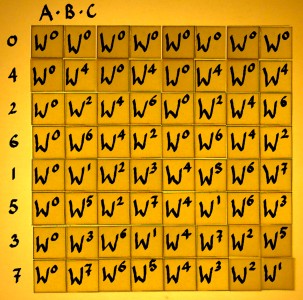 |
 |
If you would use the sketched FFT factors for correlation, the
spectrum would appear
in decimated or downsampled form. The decimation is an inherent aspect
of this FFT process. It happens stepwise: a factor 2 downsampling in
each stage. The most efficient solution is to just let it happen. At
the end of the process, it can be compensated with a bit-reversed
permutation
operation, if needed.
Bit-reversed permutation does in one operation what even-odd
decomposition does
in several stages. By the way, total decomposition, total interleave,
and bit-reversed permutation all have the same effect. A bit-reversed
permutation
operation is
illustrated here, with the indexes of the matrix written as binary
numbers:
 |
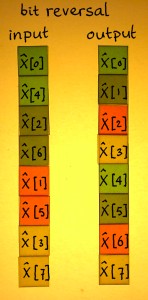 |
The Fast Fourier Transform as sketched on this page can easily be
expanded to larger N, if only N is a power of two. It is a radix 2 FFT.
Radix means base of the numeral system, and it is the Latin word for
root. Radix 2 is only one of the many options for FFT, and even for
radix 2, different schemes are possible. I am not going to discuss
these alternatives yet, because we are not even
ready
with our simple example. It can be further decomposed, increasing
efficiency one more time. That is for the next page.